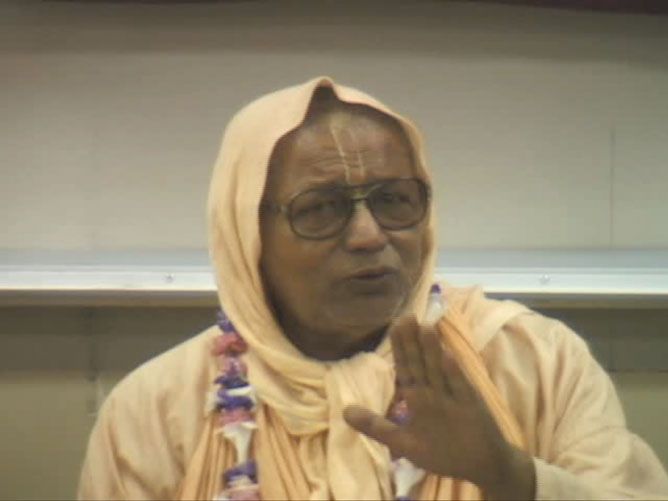TWO PATHS OF LIFE
At every step we take in life, two paths present themselves to us.
The ancient sages call these paths sreya and preya[1].
Here we will carefully assess the characteristics of these two paths
and discover the sincere seeker’s one and only choice.
Introduction
In the simplest sense, sreya means ‘good’ and preya means ‘dear’. The path of sreya leads us to what is good for us, and the path of preya leads us to what is dear to us. So, we may immediately ask, “Why are these two paths distinct? Is what is dear to us not what is best for us?” Well, for those who have yet to reach self-realisation, the answer is: “No!”[2] Let’s discuss why.
Identity
To understand the difference between sreya and preya, we first have to understand who we are. Are we the body we see when we look in the mirror? Are we the mind thinking about the text we are reading right now? No. The body and mind are covers over the true self; they are not our actual identity. We are eternal souls, atomic units of consciousness whose purpose and fulfilment are realised in the conscious world. We do not die when the body dies, and we do not gain when the mind enjoys. When we reach such awareness of our true self, the distinction between sreya and preya becomes vivid and vast.
Allusion
When we first hear of sreya and preya, they may both appeal to us. We all want both what is good for us and what is dear to us. But in the cryptic verses of the Katha-upanisad[3], we find:
The good is one thing, and the dear is another,
Though they both, with various goals, seize the soul.
Those who choose the good achieve well-being.
Those who choose the dear fall short of the real goal.
Hearing this, the first question we may ask is, “What do ‘the good’ and ‘the dear’ really mean?” Sreya, the good, alludes to what is good for the soul, our true self, and preya, the dear, alludes to what is dear to the false ego.
The basis
Preya refers to all that is pleasant, agreeable, or desirable to our false ego and its paraphernalia: the body, the senses, the mind, the intellect, and any extended sense of self we may identify with (our family, friends, nation, location, etc.). Any and all endeavours to satisfy these things that ignore the good of our true self are steps on the path of preya.
Sreya refers to all that is beneficial for the eternal soul. When fully understood, however, sreya is not only what is beneficial in general or to a relative extent but what is the most beneficial for the soul. It is defined as the good which has no equal and no superior[4]. Sreya is the superlative: our ultimate welfare, our complete fulfilment. It is the summum bonum, the highest good.
The choice
Why do people choose preya over sreya? In the next verse from the Katha-upanisad[5], we find the answer:
The good and the dear approach every human being;
Assessing and discriminating between them,
The wise choose the good over the dear,
but seeking gain and preservation thereof,
the foolish choose the dear.
The Sanskrit for ‘gain and preservation thereof’ is yoga and ksema, which more specifically mean to attain the unattained (yoga) and preserve what has already been attained (ksema). So, it is only the false ego and its desires for worldly ends that entice us to choose preya over sreya.
In this verse we are encouraged to be wise: to assess and discriminate between the paths of preya and sreya as they lay before us throughout our lives. Furthermore, we are called to action, to choose the path of sreya: to leave behind the gratification of our false ego and dedicate our lives to the highest good.
Ignorance and knowledge
The paths of preya and sreya are further described as follows[6]:
These two are extreme opposites,
Distinct in effect,
And known by the wise
As ignorance and knowledge.
Preya and sreya are opposites because they have opposite foundations: the false ego and the true self. The path of preya is called ignorance because it ignores the existence, purpose, and needs of the soul; its notion of ‘dear’ is what is dear to the false ego. The path of sreya is called knowledge because it recognises the eternal soul and leads to realisation of the soul’s true nature, purpose, and fulfilment.
The effects of sreya and preya
What are the distinct effects of preya and sreya? Where do these paths lead us? Preya leads us around the wheel of karma in the world of samsara, and sreya leads beyond the wheel of karma into the higher conscious world. The attainments and satisfaction we achieve on the path of preya are:
- temporary,
- inherently coupled with negative reactions (karma), and
- detrimental to others.
The attainments and satisfaction we achieve on the path of sreya, however, are:
- ever-lasting,
- free from any negative reactions, and
- beneficial to all.
Moreover, can the satisfaction of the false ego ever compare in quality to the satisfaction of the true self? The quality of fulfilment found on the path of sreya ultimately speaks for itself.
Conclusion
Every step we take in life is on either the path of sreya or preya. Every step leads us in a particular direction and has real, unavoidable consequences. So, we are challenged from moment to moment to mould our destiny. We are called to choose:
- The good over the “dear”
- The eternal over the temporary
- The true self over the false ego
- Knowledge over ignorance
- Spiritual joy over the bittersweet cycle of samsara
The sincere seeker answers this call to action and dedicates their life to the path of sreya.
Endnotes
4: Sri Sarartha-darsini-tika: 1.1.9
Verses for reflection
anyach chhreyo ’nyad utaiva preyas
te ubhe nanarthe purusam sinitah
tayoh sreya adadanasya sadhu
bhavati hiyate ’rthad ya u preyo vrnite
(Katha-upanisad: 1.2.1)
The good is one thing, and the dear is another,
Though they both, with various goals, seize the soul.
Those who choose the good achieve well-being.
Those who choose the dear fall short of the real goal.
sreyas cha preyas cha manusyam etas
tau samparitya vivinakti dhirah
sreyo hi dhiro ’bhipreyaso vrnite
preyo mando yoga-kseman vrnite
(Katha-upanisad: 1.2.2)
The good and the dear approach every human being;
Assessing and discriminating between them,
The wise choose the good over the dear,
but seeking gain and preservation thereof,
the foolish choose the dear.
duram ete viparite visuchi
avidya ya cha vidyeti jnata
(Katha-upanisad: 1.2.4)
These two are extreme opposites,
Distinct in effect,
And known by the wise
As ignorance and knowledge.









